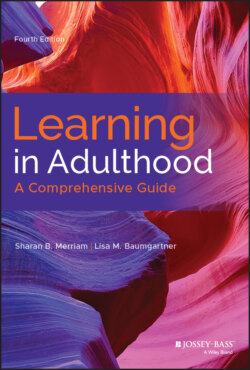Читать книгу Learning in Adulthood - Sharan B. Merriam - Страница 26
Best Practices for Online Teaching
ОглавлениеThe literature is replete with information concerning best practices for online teaching. In blended courses there are pedagogical strategies that can be used to ensure good results. The literature consistently recommends “varied interactivity and prompt feedback” (McGee & Reis, 2012). Students can interact with each other, their instructor, or course material (McGee & Reis, 2012, p. 13). Some activities that can be offered both face to face and online that exemplify active learning include group work, simulations, case studies, problem-solving exercises, and role-playing. Active learning requires “that students are aware of what they know and what they don't know using metacognitive strategies” (p. 13). Blended courses may lend themselves to students' thinking about their thinking (metacognition) and therefore discussions are important. Typically, face-to-face discussions are used “for clarification, application of knowledge, or peer critique” (p. 13).
Researchers conducted a multiple-case study with six exemplary online teachers to learn their online teaching practices (Baran, Correia, & Thompson, 2013). As can be seen in Table 2.3, Knowing and creating course content was the first theme. The teaching strategies included “breaking course content into manageable chunks,” “adopting the content from face-to-face courses,” and “getting student input into course creation” (p. 13). They noted the importance of giving feedback to students immediately and creating a conceptual outline of the course and matching “learning outcomes with course activities” (p. 23). Knowing the students was another theme. They gathered information from student introductions, communicated frequently with students, and used video and text chat to get to know their students. Guiding student learning was accomplished by “giving frequent feedback,” “using discussion boards and group emails to provide group synergy,” “using online office hours,” and “resolving issues right away” (p. 13). Enhancing the student–teacher relationship was done through “using video conferences, sharing personal information on course wikis, and establishing trust through frequent communication” (p. 13). Evaluating the online courses was the next theme. Teachers used midsemester and final course evaluations to improve their courses and implemented evaluation tools designed for online courses” (p. 13). Last, Sustaining teacher presence was done by using online videos to present content, provide updates, and give feedback to students. Teachers made communication a priority.
Table 2.3 Exemplary Online Teaching Practices
SOURCE: Adapted from Baran, Correia & Thompson (2013), pp. 13, 23.
| Theme | Teaching Strategies |
| Knowing and creating course content | Break course content into manageable chunks.Adopt the content from face-to-face courses.Get student input into course creation.Give feedback to students immediately.Create a conceptual outline of the course.Match learning outcomes with course activities. |
| Knowing the students | Gather information from student introductions.Communicate frequently with students.Use video and text chat. |
| Guiding student learning | Give frequent feedback.Use discussion boards and group e-mails to provide group synergy.Use online office hours.Resolve issues right away. |
| Enhancing the student–teacher relationship | Use video conferences.Share personal information on course wikis.Establish trust through frequent communication. |
| Evaluating the online courses | Use midsemester and final course evaluations to improve courses.Implement evaluation tools designed for online courses. |
| Sustaining teacher presence | Use online videos to present content.Provide updates.Give feedback to students.Make communication a priority. |
Given the popularity of MOOCs, scholars conducted a literature review of studies that discussed “innovations in scalable (italics in original) (not requiring any physical presence or manual grading or feedback) [active] learning strategies” (Davis, Chen, Hauff, & Houben, 2018, p. 327). They reviewed 126 studies that met the following criteria: the learning strategy discussed had to be scalable; “the evidence [came] from empirical analyses of randomized controlled experiences with a combined sample size of at least ten across all conditions” and the subjects were at least 18 years old (p. 328). The most scalable techniques included cooperative learning, simulations and gaming, and interactive multimedia. Learners involved in competitive games had higher test scores than learners who were not competing (Cagiltay, Ozcelik & Ozcelik, 2015, as cited in Davis et al., 2018). However, games and simulations are costly to develop so institutions must first determine if the investment is worth the reward.
